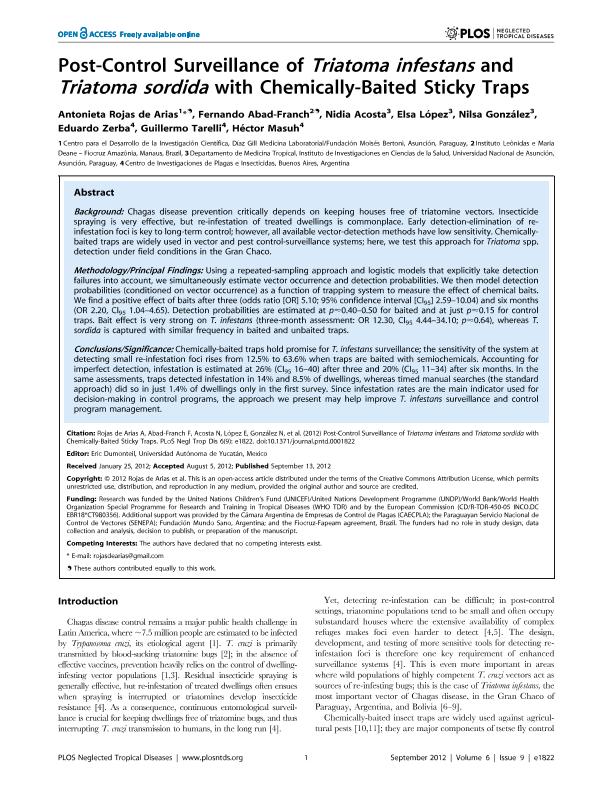Mostrar el registro sencillo del ítem
dc.contributor.author
Rojas de Arias, Antonieta
dc.contributor.author
Abad Franch, Fernando
dc.contributor.author
Acosta, Nidia

dc.contributor.author
López, Elsa
dc.contributor.author
González, Nilsa
dc.contributor.author
Zerba, Eduardo Nicolás

dc.contributor.author
Tarelli, Guillermo
dc.contributor.author
Masuh, Hector Mario

dc.date.available
2019-08-20T19:32:37Z
dc.date.issued
2012-09
dc.identifier.citation
Rojas de Arias, Antonieta; Abad Franch, Fernando; Acosta, Nidia; López, Elsa; González, Nilsa; et al.; Post-Control Surveillance of Triatoma infestans and Triatoma sordida with Chemically-Baited Sticky Traps; Public Library of Science; PLoS Neglected Tropical Diseases; 6; 9; 9-2012; 1-10
dc.identifier.issn
1935-2735
dc.identifier.uri
http://hdl.handle.net/11336/81854
dc.description.abstract
Background: Chagas disease prevention critically depends on keeping houses free of triatomine vectors. Insecticide spraying is very effective, but re-infestation of treated dwellings is commonplace. Early detection-elimination of re-infestation foci is key to long-term control; however, all available vector-detection methods have low sensitivity. Chemically-baited traps are widely used in vector and pest control-surveillance systems; here, we test this approach for Triatoma spp. detection under field conditions in the Gran Chaco. Methodology/Principal Findings: Using a repeated-sampling approach and logistic models that explicitly take detection failures into account, we simultaneously estimate vector occurrence and detection probabilities. We then model detection probabilities (conditioned on vector occurrence) as a function of trapping system to measure the effect of chemical baits. We find a positive effect of baits after three (odds ratio [OR] 5.10; 95% confidence interval [CI95] 2.59-10.04) and six months (OR 2.20, CI95 1.04-4.65). Detection probabilities are estimated at p ≈ 0.40-0.50 for baited and at just p ≈ 0.15 for control traps. Bait effect is very strong on T. infestans (three-month assessment: OR 12.30, CI95 4.44-34.10; p ≈ 0.64), whereas T. sordida is captured with similar frequency in baited and unbaited traps. Conclusions/Significance: Chemically-baited traps hold promise for T. infestans surveillance; the sensitivity of the system at detecting small re-infestation foci rises from 12.5% to 63.6% when traps are baited with semiochemicals. Accounting for imperfect detection, infestation is estimated at 26% (CI95 16-40) after three and 20% (CI95 11-34) after six months. In the same assessments, traps detected infestation in 14% and 8.5% of dwellings, whereas timed manual searches (the standard approach) did so in just 1.4% of dwellings only in the first survey. Since infestation rates are the main indicator used for decision-making in control programs, the approach we present may help improve T. infestans surveillance and control program management.
dc.format
application/pdf
dc.language.iso
eng
dc.publisher
Public Library of Science

dc.rights
info:eu-repo/semantics/openAccess
dc.rights.uri
https://creativecommons.org/licenses/by-nc-sa/2.5/ar/
dc.subject
Triatoma Infestans
dc.subject
Semiochemicals
dc.subject
Sticky Traps
dc.subject
Chagas Disease
dc.subject.classification
Otras Biotecnologías de la Salud

dc.subject.classification
Biotecnología de la Salud

dc.subject.classification
CIENCIAS MÉDICAS Y DE LA SALUD

dc.title
Post-Control Surveillance of Triatoma infestans and Triatoma sordida with Chemically-Baited Sticky Traps
dc.type
info:eu-repo/semantics/article
dc.type
info:ar-repo/semantics/artículo
dc.type
info:eu-repo/semantics/publishedVersion
dc.date.updated
2019-08-16T18:45:07Z
dc.journal.volume
6
dc.journal.number
9
dc.journal.pagination
1-10
dc.journal.pais
Estados Unidos

dc.journal.ciudad
San Francisco
dc.description.fil
Fil: Rojas de Arias, Antonieta. Fundación Moises; Paraguay
dc.description.fil
Fil: Abad Franch, Fernando. Instituto Leonidas e Maria Deane; Brasil
dc.description.fil
Fil: Acosta, Nidia. Universidad Nacional de Asunción; Paraguay
dc.description.fil
Fil: López, Elsa. Universidad Nacional de Asunción; Paraguay
dc.description.fil
Fil: González, Nilsa. Universidad Nacional de Asunción; Paraguay
dc.description.fil
Fil: Zerba, Eduardo Nicolás. Consejo Nacional de Investigaciones Científicas y Técnicas. Instituto de Investigaciones Científicas y Técnicas para la Defensa. Centro de Investigación de Plagas e Insecticidas; Argentina
dc.description.fil
Fil: Tarelli, Guillermo. Consejo Nacional de Investigaciones Científicas y Técnicas. Instituto de Investigaciones Científicas y Técnicas para la Defensa. Centro de Investigación de Plagas e Insecticidas; Argentina
dc.description.fil
Fil: Masuh, Hector Mario. Consejo Nacional de Investigaciones Científicas y Técnicas. Instituto de Investigaciones Científicas y Técnicas para la Defensa. Centro de Investigación de Plagas e Insecticidas; Argentina
dc.journal.title
PLoS Neglected Tropical Diseases

dc.relation.alternativeid
info:eu-repo/semantics/altIdentifier/url/https://journals.plos.org/plosntds/article?id=10.1371/journal.pntd.0001822
dc.relation.alternativeid
info:eu-repo/semantics/altIdentifier/doi/https://doi.org/10.1371/journal.pntd.0001822
Archivos asociados
